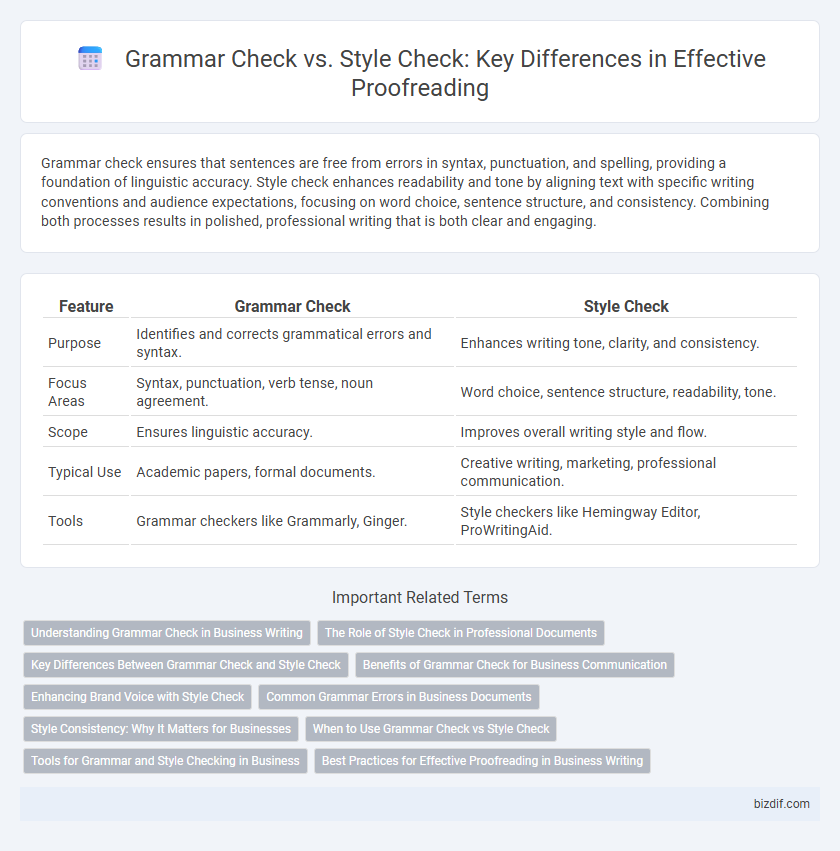Grammar check ensures that sentences are free from errors in syntax, punctuation, and spelling, providing a foundation of linguistic accuracy. Style check enhances readability and tone by aligning text with specific writing conventions and audience expectations, focusing on word choice, sentence structure, and consistency. Combining both processes results in polished, professional writing that is both clear and engaging.
Table of Comparison
| Feature | Grammar Check | Style Check |
|---|---|---|
| Purpose | Identifies and corrects grammatical errors and syntax. | Enhances writing tone, clarity, and consistency. |
| Focus Areas | Syntax, punctuation, verb tense, noun agreement. | Word choice, sentence structure, readability, tone. |
| Scope | Ensures linguistic accuracy. | Improves overall writing style and flow. |
| Typical Use | Academic papers, formal documents. | Creative writing, marketing, professional communication. |
| Tools | Grammar checkers like Grammarly, Ginger. | Style checkers like Hemingway Editor, ProWritingAid. |
Understanding Grammar Check in Business Writing
Grammar check in business writing ensures clarity and professionalism by identifying errors in syntax, verb tense, punctuation, and subject-verb agreement. It detects common pitfalls such as misplaced commas, run-on sentences, and incorrect pluralization, which can undermine a message's credibility. Mastering grammar check enhances communication effectiveness, reducing misunderstandings and fostering trust in corporate correspondence.
The Role of Style Check in Professional Documents
Style check enhances professional documents by ensuring consistency in tone, voice, and formatting, which strengthens the document's clarity and readability. Unlike grammar check, which targets syntactic accuracy and error correction, style check addresses nuances such as word choice, sentence structure, and adherence to industry-specific conventions. This meticulous attention to stylistic elements significantly improves the document's professionalism and audience engagement.
Key Differences Between Grammar Check and Style Check
Grammar check focuses on identifying and correcting errors related to syntax, punctuation, and sentence structure, ensuring the text follows standard language rules. Style check evaluates consistency, tone, and readability, refining word choice, sentence variety, and overall flow to match the intended audience and purpose. Key differences lie in grammar check addressing correctness and style check enhancing expression and engagement.
Benefits of Grammar Check for Business Communication
Grammar check enhances business communication by ensuring clarity and professionalism, reducing misunderstandings and fostering trust with clients and colleagues. It helps identify and correct syntax errors, punctuation mistakes, and subject-verb agreement issues, which can otherwise undermine the credibility of business documents. Consistent grammar use improves the overall readability of emails, reports, and proposals, leading to more effective and persuasive communication.
Enhancing Brand Voice with Style Check
Style check tools enhance brand voice by ensuring consistency in tone, vocabulary, and phrasing, aligning all content with the company's identity. Grammar check focuses on correcting errors such as punctuation, verb tense, and sentence structure but does not address stylistic nuances that distinguish a unique brand personality. Employing style check alongside grammar check refines communication, making the brand message clearer, more compelling, and instantly recognizable to the target audience.
Common Grammar Errors in Business Documents
Common grammar errors in business documents include subject-verb agreement mistakes, incorrect punctuation, and misplaced modifiers, which often obscure the intended message. Grammar checks identify these syntactical issues to ensure clarity and professionalism, while style checks focus on tone, consistency, and formality to align with business communication standards. Using both tools enhances the accuracy and effectiveness of business writing by addressing structural correctness and stylistic appropriateness.
Style Consistency: Why It Matters for Businesses
Style consistency ensures brand voice uniformity across all business communications, enhancing professionalism and customer trust. Grammar checks identify syntax and usage errors, while style checks maintain coherent tone, format, and terminology that align with corporate standards. Maintaining style consistency reduces misinterpretations and strengthens brand identity in competitive markets.
When to Use Grammar Check vs Style Check
Grammar Check should be used when ensuring sentence structure, punctuation, and spelling are correct to maintain clarity and prevent misunderstandings. Style Check is ideal for refining tone, consistency, and readability to match the intended audience and purpose of the text. Use Grammar Check during initial drafting phases and Style Check during final revisions to enhance overall quality and professionalism.
Tools for Grammar and Style Checking in Business
Effective business communication relies on both grammar check and style check tools to ensure clarity and professionalism. Grammar check tools identify errors in syntax, punctuation, and verb tense, while style check tools focus on tone, word choice, and sentence structure to maintain brand consistency. Popular platforms like Grammarly, ProWritingAid, and Hemingway Editor combine these features to optimize business writing and reduce costly miscommunications.
Best Practices for Effective Proofreading in Business Writing
Grammar check and style check serve distinct purposes in business writing proofreading; grammar check identifies errors in syntax, punctuation, and sentence structure, while style check ensures consistency in tone, word choice, and formatting. Best practices for effective proofreading involve using advanced tools like Grammarly or Hemingway Editor combined with manual reviews to catch nuanced issues beyond automated corrections. Emphasizing clarity, conciseness, and adherence to company style guides enhances professionalism and improves communication impact.
Grammar Check vs Style Check Infographic

 bizdif.com
bizdif.com